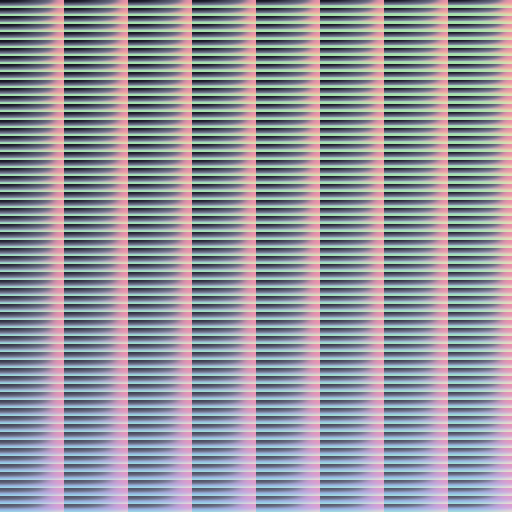lutgen-rs
A blazingly fast interpolated LUT generator and applicator for arbitrary and popular color palettes. Theme any image to your dekstop colorscheme!
Example
Usage
Note: The binary and library are still in a fairly experimental state, and breaking changes are made quite often. Any release that does make any changes as such, are bumped to 0.X.0
CLI
Source
git clone https://github.com/ozwaldorf/lutgen-rs
cd lutgen-rs
cargo install --path .Releases
| Packaging Status | Installation Command |
|---|---|
 |
cargo install lutgen |
yay -S lutgen-bin |
|
apk add lutgen |
Helptext
A blazingly fast interpolated LUT generator and applicator for arbitrary and popular color palettes.
Usage: lutgen [OPTIONS] [CUSTOM_COLORS]... [COMMAND]
Commands:
apply Correct an image using a hald clut, either generating it, or loading it externally
help Print this message or the help of the given subcommand(s)
Arguments:
[CUSTOM_COLORS]... Custom hexidecimal colors to add to the palette. If `-p` is not used to specify a base palette, at least 1 color is required
Options:
-o, --output <OUTPUT> Path to write output to
-p, --palette <PALETTE> Predefined popular color palettes. Use `lutgen -p` to view all options. Compatible with custom colors
-l, --level <LEVEL> Hald level (ex: 8 = 512x512 image) [default: 8]
-a, --algorithm <ALGORITHM> Algorithm to remap the LUT with [default: gaussian-rbf] [possible values: shepards-method, gaussian-rbf, linear-rbf, gaussian-sampling, nearest-neighbor]
-n, --nearest <NEAREST> Number of nearest palette colors to consider at any given time for RBF based algorithms. 0 uses unlimited (all) colors [default: 16]
-s, --shape <SHAPE> Gaussian RBF's shape parameter. Higher means less gradient between colors, lower mean more [default: 96]
--power <POWER> Shepard algorithm's power parameter [default: 4]
-m, --mean <MEAN> Gaussian sampling algorithm's mean parameter [default: 0]
--std-dev <STD_DEV> Gaussian sampling algorithm's standard deviation parameter [default: 20]
-i, --iterations <ITERATIONS> Gaussian sampling algorithm's target number of samples to take for each color [default: 512]
-h, --help Print help (see more with '--help')
-V, --version Print version
Examples
Generating a LUT
lutgen -p catppuccin-mocha -o mocha_lut.pngCorrecting an image with a LUT generated on the fly
lutgen -p catppuccin-mocha apply assets/simon-berger-unsplash.jpg -o mocha_version.pngCorrecting an image with a pre-generated LUT
lutgen apply --hald-clut mocha_lut.png input.jpgCorrecting Videos (using ffmpeg):
ffmpeg -i input.mkv -i hald_clut.png -filter_complex '[0][1] haldclut' output.mp4Library
By default, the
binfeature and dependencies are enabled. When used as a library, it's recommended to usedefault-features = falseto minimalize the dependency tree and build time.
Generating a LUT (simple):
use exoquant::SimpleColorSpace;
use lutgen::{
GenerateLut,
interpolation::{
GaussianRemapper, GaussianSamplingRemapper
},
};
use lutgen_palettes::Palette;
// Get a premade palette
let palette = Palette::CatppuccinMocha.get();
// Setup the fast Gaussian RBF algorithm
let (shape, nearest) = (96.0, 0);
let remapper = GaussianRemapper::new(&palette, shape, nearest);
// Generate and remap a HALD:8 for the provided palette
let hald_clut = remapper.generate_lut(8);
// hald_clut.save("output.png").unwrap();
// Setup another palette to interpolate from, with custom colors
let palette = vec![
[255, 0, 0],
[0, 255, 0],
[0, 0, 255],
];
// Setup the slower Gaussian Sampling algorithm
let (mean, std_dev, iters, seed) = (0.0, 20.0, 512, 420);
let remapper = GaussianSamplingRemapper::new(
&palette,
mean,
std_dev,
iters,
seed,
SimpleColorSpace::default()
);
// Generate and remap a HALD:4 for the provided palette
let hald_clut = remapper.generate_lut(4);
// hald_clut.save("output.png").unwrap();Applying a LUT:
use image::open;
use lutgen::{
identity::correct_image,
interpolation::GaussianRemapper,
GenerateLut,
};
use lutgen_palettes::Palette;
// Generate a hald clut
let palette = Palette::CatppuccinMocha.get();
let remapper = GaussianRemapper::new(&palette, 96.0, 0);
let hald_clut = remapper.generate_lut(8);
// Save the LUT for later
hald_clut.save("docs/catppuccin-mocha-hald-clut.png").unwrap();
// Open an image to correct
let mut external_image = open("docs/example-image.jpg").unwrap().to_rgb8();
// Correct the image using the hald clut we generated
correct_image(&mut external_image, &hald_clut);
// Save the edited image
external_image.save("docs/catppuccin-mocha.jpg").unwrap()Remapping an image directly (advanced):
Note: While the remappers can be used directly on an image, it's much faster to remap a LUT and correct an image with that.
use lutgen::{
GenerateLut,
interpolation::{GaussianRemapper, InterpolatedRemapper},
};
// Setup the palette to interpolate from
let palette = vec![
[255, 0, 0],
[0, 255, 0],
[0, 0, 255],
];
// Setup a remapper
let (shape, nearest) = (96.0, 0);
let remapper = GaussianRemapper::new(&palette, shape, nearest);
// Generate an image (generally an identity lut to use on other images)
let mut hald_clut = lutgen::identity::generate(8);
// Remap the image
remapper.remap_image(&mut hald_clut);
// hald_clut.save("output.png").unwrap();Tasks
- Basic hald-clut identity generation
- Gaussian Sampling interpolation for generating LUTs (thanks Gengeh for the original imagemagick strategy!)
- Support a bunch of popular base color palettes (thanks Wezterm!)
- Basic applying a lut to an image
- Radial basis function interpolation for generating LUTs
- Interpolation for more accuracy when correcting with low level luts (<16)
- Replace exoquant and kiddo with a unified implementation of a k-d tree
Sources
- Hald Cluts: https://www.quelsolaar.com/technology/clut.html
- Editing with Hald Cluts: https://im.snibgo.com/edithald.htm
- Sparse Hald Cluts: https://im.snibgo.com/sphaldcl.htm
- RBF Interpolation: https://en.wikipedia.org/wiki/Radial_basis_function_interpolation
- Shepard's method: https://en.wikipedia.org/wiki/Inverse_distance_weighting
- Oklab Colorspace: https://bottosson.github.io/posts/oklab/
Special Thanks
- Stonks3141 for maintaining the Alpine Linux package






